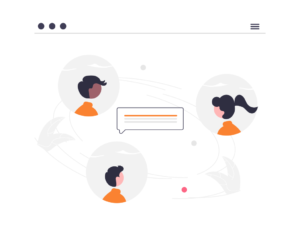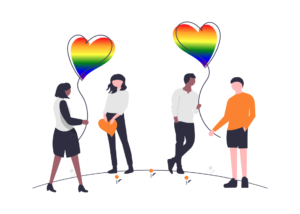
Intro: A Look Into Successful Dating Apps
Evaluating the major players in the dating app market reveals a lot about how to build a successful data app. The likes of Tinder, Bumble, and Hinge have captured significant market share and achieved remarkable success by offering unique features and catering to specific user preferences. Tinder, for instance, revolutionised the dating app landscape with its iconic “swipe” feature, allowing users to quickly browse through potential matches. Bumble, on the other hand, empowered women by giving them the exclusive ability to initiate conversations, challenging traditional gender norms.
Emerging trends and innovations in the dating app industry are continuously shaping the user experience and driving further growth. Artificial intelligence (AI) and machine learning algorithms are being integrated into dating apps to provide more accurate and personalised match recommendations. Further, generative AI models such as Open AI’s ChatGPT are being used to foster creativity and prompt interaction in ways we have never seen before.
Identify Your Niche and Target Audience

Understanding how to build a successful dating app starts with identifying your niche and audience. The dating app market is saturated, so finding a specific demographic or community to cater to can give you a competitive edge. Conduct thorough market research to understand the preferences, behaviours, and pain points of your target users.
Consider factors such as age range, location, interests, sexual orientation, cultural background, or any other defining characteristics. This will help you tailor your app’s features and marketing efforts more effectively. For example, you could create a dating app specifically for single parents, outdoor enthusiasts, or members of the LGBTQ+ community.
Analysing user demographics and preferences will not only help you create a more targeted and appealing product, but it will also inform your branding, user acquisition strategies, and overall positioning in the market. By catering to a specific niche, you can build a loyal and engaged user base. This is essential for the long-term success of your dating app.
Conducting market research involves methods such as surveys, focus groups, competitor analysis, and data mining from existing dating platforms. Gather insights into what users value most in a dating app, what features they find most useful or frustrating, and what unmet needs exist in the market. This information will guide your app’s design, functionality, and unique selling proposition.
Key Features for a Successful Dating App
Understanding how to build a successful dating app requires a focus on key features. Prioritise a seamless onboarding process, user-friendly interface design, and intuitive navigation and features. Firstly, the onboarding process should be quick and effortless, allowing users to sign up and create their profiles with minimal friction. Consider offering multiple sign-up options, such as connecting through social media accounts or using phone numbers, to cater to different user preferences.
Secondly, the interface design plays a crucial role in the overall user experience. A clean, modern, and visually appealing layout can make your app stand out from the competition. Ensure that the design is consistent across all screens and adheres to platform-specific design guidelines. Incorporate intuitive gestures and animations that enhance the overall user experience, such as swiping gestures for matching or liking profiles.
Thirdly, the navigation and features should be intuitive and easy to use. Implement a straightforward matching system that allows users to quickly browse through potential matches based on their preferences and interests. Incorporate advanced filtering options to help users narrow down their search and find compatible partners efficiently. Furthermore, consider adding unique features that set your app apart, such as video introductions, personality quizzes, or compatibility assessments.
Safety Precautions

In the digital age, safety should be a top priority when considering how to build a successful dating app. Implementing robust identity verification and background check measures is crucial to ensure users feel secure and confident in their interactions. This not only helps weed out fake profiles but also provides an additional layer of security against potential predators or individuals with malicious intent.
A comprehensive identity verification process could involve requiring users to submit government-issued identification documents, such as a driver’s license or passport. Facial recognition technology can then be employed to match the user’s profile picture with their identification photo, confirming their identity. Additionally, background checks can be conducted to screen for any concerning criminal records or red flags.
Privacy and data protection are equally vital components of how to build a successful dating app. Users entrust these platforms with sensitive personal information, and it’s imperative to implement stringent measures to safeguard this data. Employing end-to-end encryption for all communications and storing user data on secure servers with robust access controls are essential steps in maintaining user trust and compliance with data protection regulations.
Furthermore, a comprehensive reporting and blocking mechanism empowers users to take action against any inappropriate or concerning behaviour. This feature should be easily accessible and user-friendly, allowing individuals to report offensive messages, images, or profiles swiftly. Once a report is filed, a dedicated team should promptly investigate and take appropriate action, which could range from issuing warnings to permanently banning offenders from the platform.
By prioritising safety through identity verification, background checks, data protection, and robust reporting systems, dating apps can cultivate a secure and trustworthy environment for their users. This not only enhances the overall user experience but also fosters a community built on mutual respect and responsible online behaviour.
Understanding how to build a successful dating app involves focusing on these key aspects. With the right approach, your dating app can thrive in this competitive market, providing valuable and meaningful connections for its users.
Integrating Innovative Technologies

To stand out in the crowded dating app market, incorporating cutting-edge technologies is paramount. Machine learning and artificial intelligence can provide a more personalised and seamless experience for users.
One area where AI can make a significant impact is personality compatibility analysis. By leveraging natural language processing and machine learning algorithms, your app can identify traits, values, and interests from user profiles and interactions. This data can suggest highly compatible matches, increasing the likelihood of genuine connections and long-lasting relationships.
Location-based matching is another area where AI can shine. By using geolocation data and machine learning models, your app can suggest potential matches within a user’s desired proximity or location preferences. This enhances convenience and increases the chances of successful in-person meet-ups and dates.
Additionally, machine learning can continuously optimise and refine the matching algorithms, making the app’s recommendations more accurate over time. By analysing user feedback and success rates, AI can dynamically adjust its criteria, creating a self-improving system that delivers better results.
Incorporating these innovative technologies not only sets your dating app apart but also provides users with a more tailored and efficient experience. This ultimately increases user satisfaction and the success rate of meaningful connections.
Monetisation Models for Dating Apps
When it comes to monetising your dating app, several options can be explored. The key is to balance revenue generation and providing a compelling user experience that keeps people engaged and coming back.
Subscription Models and Premium Features: Offering a freemium model with a basic free version and paid premium tier is common. Premium features could include advanced search filters, unlimited swipes or matches, read receipts, ad-free browsing, and exclusive content. By providing tangible value, users are more likely to invest in a premium subscription for enhanced functionality and a better experience.
In-App Purchases and Virtual Gifts: Another lucrative avenue is allowing users to make in-app purchases, such as buying virtual gifts, stickers, or boosts. These can increase their visibility and chances of matching. Virtual gifts can be a fun way for users to express interest or appreciation. These purchases can provide a steady stream of revenue while adding an element of gamification to the app.
Advertising and Sponsorships: Dating platforms can generate revenue through advertising and sponsorships. This could involve displaying banner ads, sponsored profiles, or branded content within the app. However, it’s crucial to avoid overwhelming users with excessive or intrusive ads that disrupt the experience.
How do you market and promote a new dating app effectively?

Effective marketing and promotion are crucial for the success of a new dating app. One powerful strategy is leveraging social media and influencer marketing. By partnering with influencers who align with your target audience, you can tap into their established following and gain credibility through endorsements and sponsored content.
Implementing a well-designed referral program can incentivise existing users to invite their friends and social circles. Offering rewards or discounts for successful referrals can be a cost-effective way to acquire new users organically.
App store optimisation (ASO) is another essential component. Optimising your app’s listing with relevant keywords, compelling visuals, and positive reviews can significantly improve its visibility and conversion rates on app stores. Continuously refining your ASO strategy based on data and user feedback can help you stay ahead of the competition.
Encouraging Genuine Connections and Successful Matches on a Dating App

Fostering genuine connections and successful matches is paramount. A dating app must prioritise authenticity and open communication. Encouraging users to be their genuine selves when creating profiles and interacting can help. Prompts that inspire vulnerability and self-expression can attract like-minded individuals who appreciate authenticity.
Additionally, the app should facilitate open and honest communication. Features like video calls, voice messaging, and prompts for thoughtful questions can help users connect on a deeper level beyond superficial details. This open communication builds trust and compatibility, increasing the chances of forming meaningful connections.
Moreover, a successful dating app should strive to build a supportive and inclusive community. This can be achieved through tools that promote respectful interactions and forums where users can share experiences and advice. By fostering a safe and supportive environment, users will feel comfortable being their genuine selves, leading to more successful matches.
Navigating Legal and Ethical Considerations
When creating a dating app, prioritising legal and ethical considerations is crucial. Compliance with data privacy regulations, preventing discrimination, and establishing ethical guidelines are vital.
Your dating app must adhere to data privacy laws like the GDPR in the UK and EU. Implementing robust data protection measures, obtaining explicit consent for data collection, and providing users with control over their personal information are essential. Failure to comply can result in hefty fines and damage your app’s reputation.
It’s essential to prevent discrimination and bias within your app’s algorithms and interactions. Regularly auditing your algorithms and promoting inclusivity are crucial steps in fostering an ethical dating environment.
Establishing clear ethical guidelines for user interactions is vital. This includes measures to combat harassment and inappropriate behaviour. Encouraging respectful communication and providing tools to report and block violations can cultivate a safe community.
By prioritising legal and ethical considerations, you protect your users and build trust and credibility for your dating app. Demonstrating a commitment to privacy, fairness, and ethical conduct can differentiate your app and attract users who value these principles.
Robust Infrastructure and Scalability
Building a dating app requires a robust and scalable infrastructure. Investing in a reliable and secure cloud-based platform ensures a seamless user experience, even during peak usage times. Load balancing and caching mechanisms can help distribute the workload and improve response times.
As your user base grows, your app must scale seamlessly without compromising performance. Utilising containerisation technologies like Docker or Kubernetes can simplify deployment and scaling across multiple servers or cloud instances. Regularly monitoring and optimising your app’s performance is also essential to address potential bottlenecks before they become issues.
Continuous Innovation and Feature Updates
The dating app market is competitive, and user preferences are always evolving. Continuous innovation and new features can keep your app relevant and engaging. Regularly gathering user feedback and analysing usage data can help identify areas for improvement and new feature opportunities.
An agile development approach can streamline the process of ideating, developing, and releasing new features. This allows for rapid iteration based on user feedback, ensuring your app remains appealing for your target audience. Leveraging emerging technologies like AI can unlock new possibilities for personalised matchmaking and intelligent recommendation systems.
Customer Support and User Feedback

Exceptional customer support is crucial for building trust and fostering a positive user experience. Implementing multiple support channels, such as in-app messaging, email, and social media, ensures users can easily reach out for assistance. Promptly addressing user concerns can go a long way in retaining users and cultivating a positive reputation.
Actively soliciting user feedback through surveys, ratings, and reviews provides valuable insights into areas for improvement and new feature ideas. Establishing a feedback loop and showing a commitment to addressing user concerns can foster a sense of loyalty among your user base.
How to Create a Dating App That Caters to Diverse Niches and Inclusive Communities

In today’s diverse world, it’s crucial for dating apps to promote inclusivity and representation.
Conduct thorough market research to understand the unique needs and preferences of different communities. Engage with focus groups, survey potential users, and collaborate with community leaders to gain insights.
Designing your app’s user interface and features should prioritise inclusivity and accessibility. Offer customisable gender identity and sexual orientation options. Ensure your app is compatible with assistive technologies for users with disabilities. Provide language options and culturally relevant content to cater to diverse audiences.
To address cultural sensitivities, understand the values and norms of the communities you aim to serve. Consult with cultural experts or advisors to ensure your app’s content and messaging are respectful.
Implement robust safety measures and moderation systems to create a safe environment. This may include identity verification and reporting mechanisms for harassment. Promote diversity and representation in your marketing and branding efforts. Collaborate with influencers and community leaders to amplify your message.
Success Stories and Lessons Learned in the Dating App Industry

Some dating apps have managed to stand out and achieve remarkable success. Examining these success stories and learning from failures provides valuable insights.
Tinder revolutionised the dating app landscape with its “swipe” mechanic. Its user-friendly interface and marketing campaigns contributed to rapid growth. However, it faced criticism for promoting superficial connections.
Bumble, founded by a former Tinder co-founder, gives women more control over initiating conversations. This unique approach, combined with a focus on safety, has resonated with many users.
Apps like OkCupid and eHarmony focus on compatibility algorithms and have built loyal user bases by catering to those seeking meaningful connections. Their success shows the value of offering a differentiated experience tailored to user needs.
Failures in the dating app industry also offer valuable lessons. The now-defunct app Badoo faced backlash for lax security measures and fake profiles. This emphasises the importance of robust user verification and moderation systems. Grindr has been criticised for enabling discrimination, highlighting the need for strong community guidelines.
Successful dating apps often prioritise user experience, safety, and community building. They invest in user research, iterative design, and data-driven decision-making. Leveraging technologies like AI enhances matchmaking and personalisation.
Creating a successful dating app requires understanding user needs, fostering a safe environment, and the ability to continuously innovate and adapt to changing market dynamics.
